The Chandelier Cluster is a globular cluster located approximately 28,400 light-years away in the southern constellation of Sagittarius (the Archer). With an apparent magnitude of 6.8 and an apparent size of 11 arcminutes, it can be spotted in binoculars or a small telescope. The bright globular cluster is listed as NGC 6723 in the New General Catalogue.
NGC 6723 has a mass of 357,000 Suns. About half of the cluster’s mass lies within the central 30 – 35 light-years. The cluster has a Shapley-Sawyer Concentration Class of VII, indicating an intermediate loose concentration of stars.
Even though the Chandelier Cluster formed at around the same time as some of the Milky Way’s oldest globular clusters, it has a high metallicity and is mostly composed of younger stars. This indicates that the cluster has had several much more recent stages of star formation.
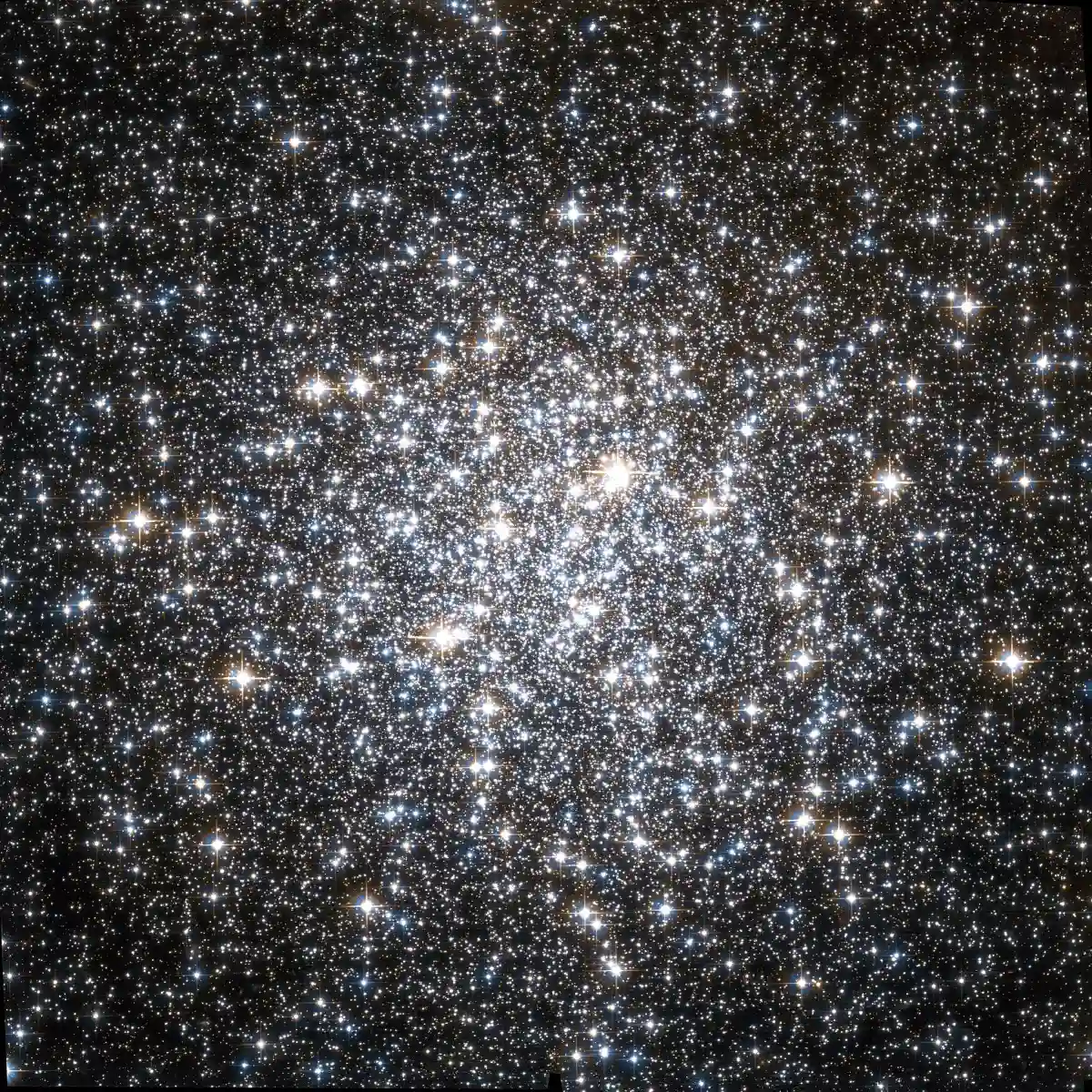
The Chandelier Cluster (NGC 6723) by the Hubble Space Telescope (HST), image credit: ESA, Hubble & NASA (PD)
The brightest stars in the cluster are catalogued as NGC 6723 456 and NGC 6723 171 and have apparent magnitudes of 12.57 and 12.58. The cluster is rich in RR Lyrae variables, pulsating A- or F-type stars on the horizontal branch (HB) that are used as standard candles to measure distances to galactic and extragalactic objects.
The Chandelier Cluster has an estimated age of 13.06 billion years. It stretches over 100 light-years across. Like all globular clusters, it contains multiple populations of stars.
A 2019 study authored by Jae-Woo Lee of the Department of Physics and Astronomy, Sejong University, Seoul, Korea, found that the first generation of stars comprise only a very small fraction of the cluster. These primordial stars account for only 0.363 ± 0.017 percent of the total stellar population in NGC 6723. The study also identified two populations of stars on the red giant branch (RGB) in the cluster. The findings were based on observations of NGC 6723 with the CTIO 1.0m telescope at the Cerro Tololo Inter-American Observatory (CTIO) in northern Chile from September 2007 to May 2014.
The loosely packed collection of stars is believed to be part of the Milky Way’s bulge because of its proximity to the Galactic centre and high metal content. It lies around 2,850 parsecs from the Milky Way’s central supermassive black hole. However, based on the cluster’s kinematics, a 2003 study argued that NGC 6723 resides in the Milky Way’s inner halo.
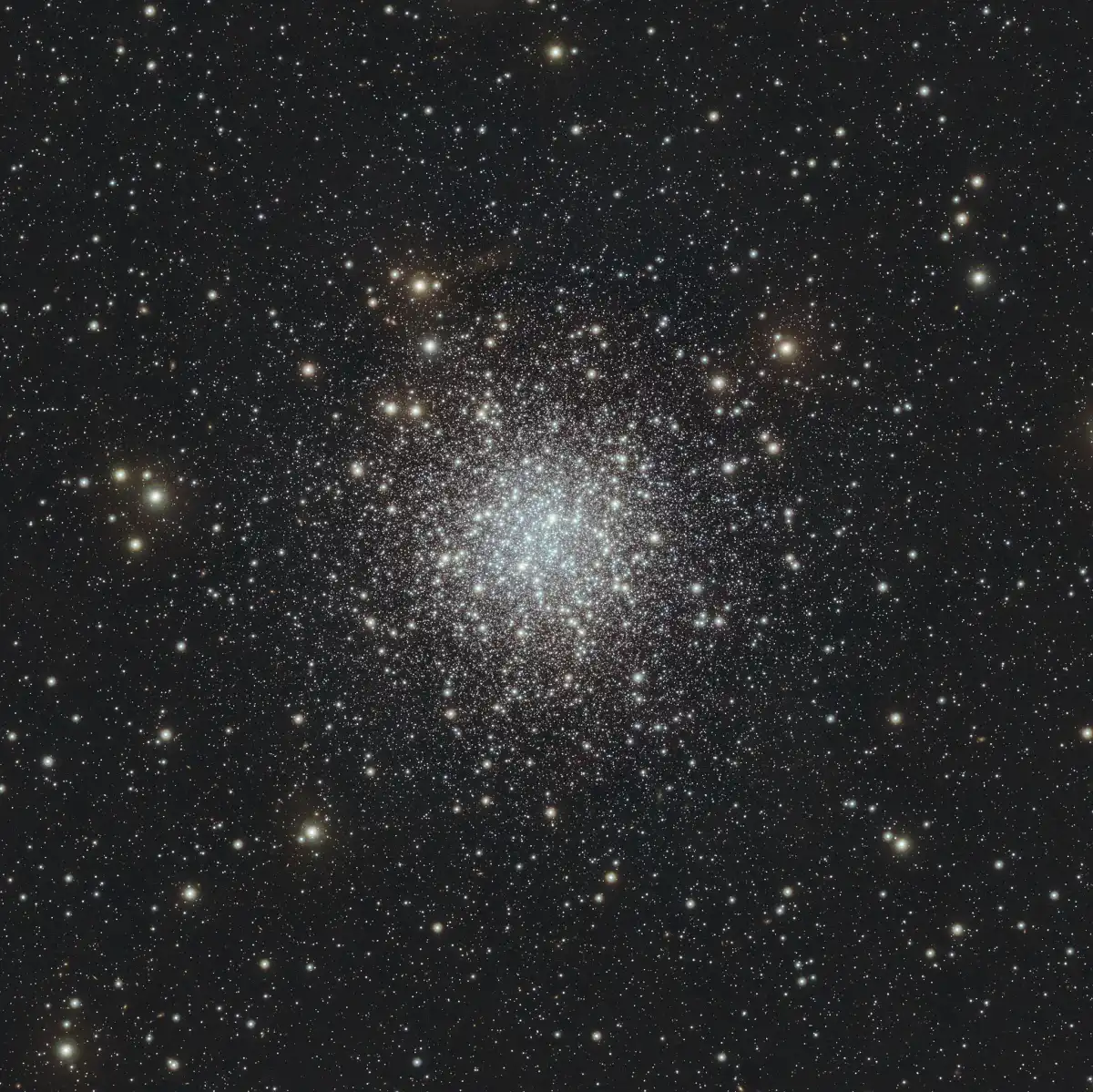
This Picture of the Week — taken with ESO’s Visible and Infrared Survey Telescope (VISTA) at Paranal Observatory in Chile — might look like a scene from a snowy winter’s night, but it’s not. It’s an infrared image of NGC 6723, a globular cluster located about 28 000 light years from Earth in the constellation Sagittarius. Globular clusters are spherical-shaped groups of stars, tightly bound together by gravity. Their name is derived from the Latin word globulus, meaning small sphere — somewhat misleading given that NGC 6723, as most globular clusters, contains hundred of thousands to millions of stars. So far, astronomers have found more than 150 globular clusters in our galaxy, the Milky Way, with most of them estimated to be at least 10 billion years old and hosting some of the oldest stars in the galaxy. Globular clusters were key to pinpointing our own location within the Milky Way in the early 20th century. American astronomer Harlow Shapley measured the distances to several globular clusters, and noticed that they were arranged in a roughly spherical distribution, but the Sun was not at its centre. He correctly inferred that the heart of the Milky Way lies at the centre of this distribution of globular clusters, placing the Sun in the suburbs of the galaxy. Image credit: ESO/S. Meingast et al. (CC BY 4.0)
Facts
The Chandelier Cluster was discovered by the Scottish astronomer James Dunlop using a 9-inch reflector from the Parramatta Observatory near Sydney, New South Wales, Australia, on June 2, 1826. Dunlop catalogued the object as Dunlop 573, noting, “A beautiful bright round nebula, about 3.5’ diameter, moderately and gradually condensed to the centre.”
English astronomer John Herschel observed the cluster on August 31, 1834, and provided a more accurate position.
The nearby nebulae NGC 6726, NGC 6727 and NGC 6729 were discovered by the German astronomer Julius Schmidt in 1860 and 1861, and IC 4812 by American astronomer DeLisle Stewart in 1899. These nebulae appear south of the cluster.
Danish astronomer John Louis Emil Dreyer, who compiled the New General Catalogue, described NGC 6723 as a “a globular cluster, very large, very little extended, very gradually brighter middle, well resolved, clearly consisting of stars, stars from 14th to 16th magnitude.”
In 2021, astronomers discovered a star, catalogued as 2M18594405−3651518, that resides outside NGC 6723 but is believed to have once been a member because it moves on a similar orbit. It is one of the nitrogen-enhanced stars commonly found in the Milky Way’s bulge. The discovery suggests that some of these ejected stars once belonged to globular clusters that were tidally disrupted.
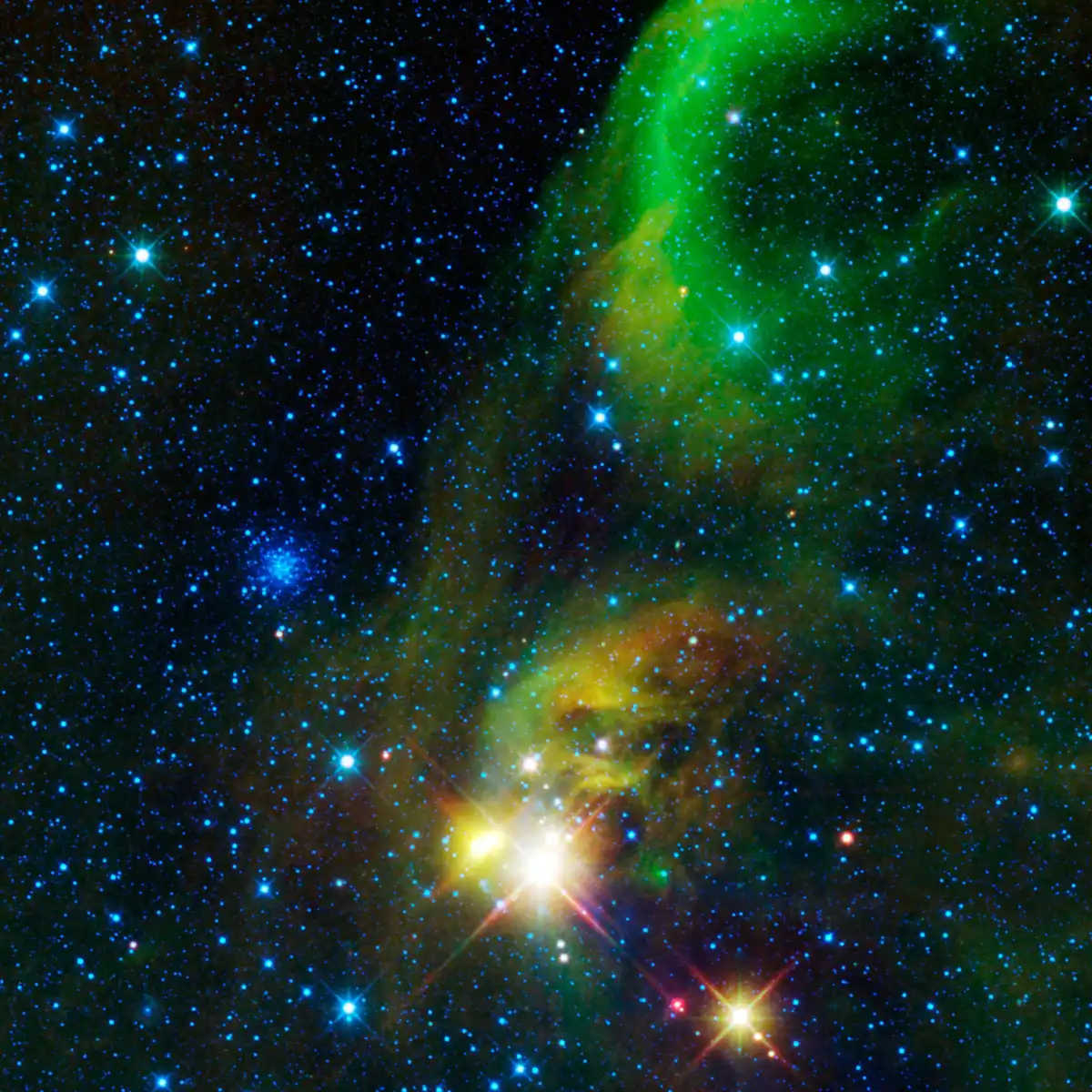
This colorful image from NASA’s WISE (Wide-field Infrared Survey Explorer) is a view of an area of the sky over 12 times the size of the full Moon on the border of the constellations Sagittarius and Corona Australis. Two types of star clusters are visible in the image. The wispy nebula running top to bottom of this image is a nearby star forming region. In visible light the dust within the nebula obscures and reflects the light of the stars within and behind it, giving rise to several catalogued nebula (NGC 6726, NGC 6727, NGC 6729, IC 4812). But here in infrared light we see the light of the dust itself as it is warmed by the light of the newborn stars in the cluster (green and red). We also see through the dust to peer at the stars nestled within (blue/cyan). This star cluster has been called the Coronet Cluster. It is located some 420 light-years from Earth, and stretches about 10 light-years across. The Coronet Cluster is a relatively loose cluster of only a few dozen stars, many of which are only a few million years old. Just to the left of center is a very different kind of star cluster. NGC 6723 is a globular star cluster located some 29,000 light-years away from Earth, and spans about 65 light-years in size. Globular star clusters contain hundreds of thousands to millions of stars and orbit around the Galaxy in a spherical halo surrounding it. These are some of the oldest stars in the Universe, over 10 billion years old. All four infrared detectors aboard WISE were used to make this image. Color is representational: blue and cyan represent infrared light at wavelengths of 3.4 and 4.6 microns, which is dominated by light from stars. Green and red represent light at 12 and 22 microns, which is mostly light from warm dust. Credit: NASA, Caltech (PD)
Location
The Chandelier Cluster is located in the southern part of Sagittarius, south of the Teapot pattern and next to the border with Corona Australis (the Southern Crown). It is visible in binoculars and can be observed in small and medium telescopes.
Several emission and reflection nebulae lie about half a degree southeast of the cluster. The reflection nebulae NGC 6726, NGC 6727 and IC 4812 and the emission and reflection nebula NGC 6729 lie in the constellation Corona Australis. They are part of the Corona Australis Molecular Cloud, a large stellar nursery that extends from Epsilon Coronae Australis in the direction of Sagittarius.
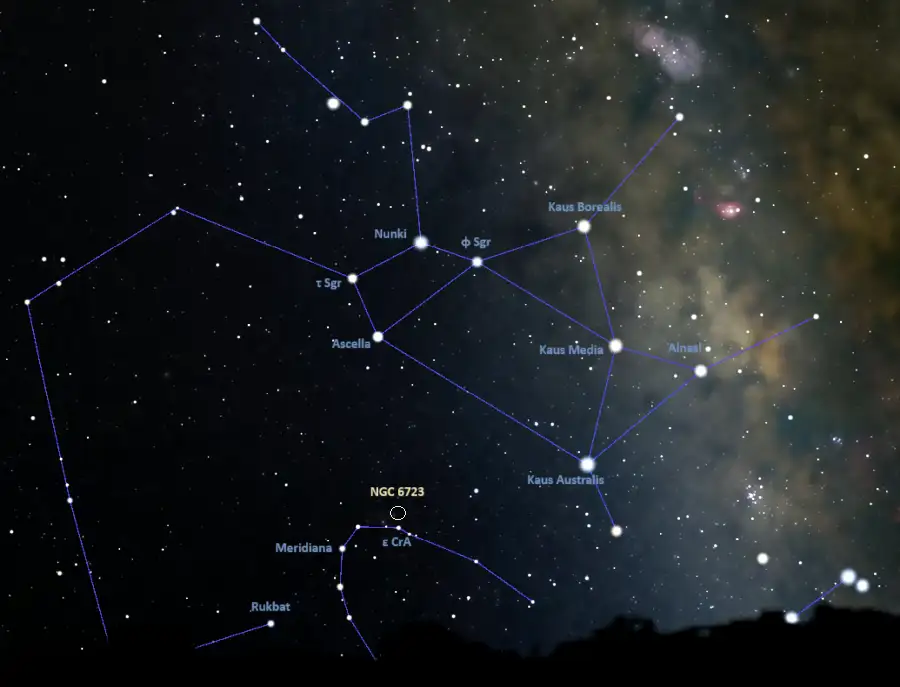
Location of the Chandelier Cluster (NGC 6723), image: Stellarium
The bright Coronet Cluster (R Coronae Australis Cluster) lies at the centre of the star forming region. The nebula NGC 6729 (the R Coronae Australis Nebula) is listed as Caldwell 68 in the Caldwell catalogue of objects visible in amateur telescopes.
The best time of the year to observe the Chandelier Cluster and other deep sky objects in Sagittarius is during the month of August, when the constellation appears higher above the horizon around 9 pm.
At declination -36° 37’, NGC 6723 is best seen from the southern hemisphere. It never rises for observers north of the latitude 53° N and only appears low above the horizon for observers in the mid-northern latitudes.
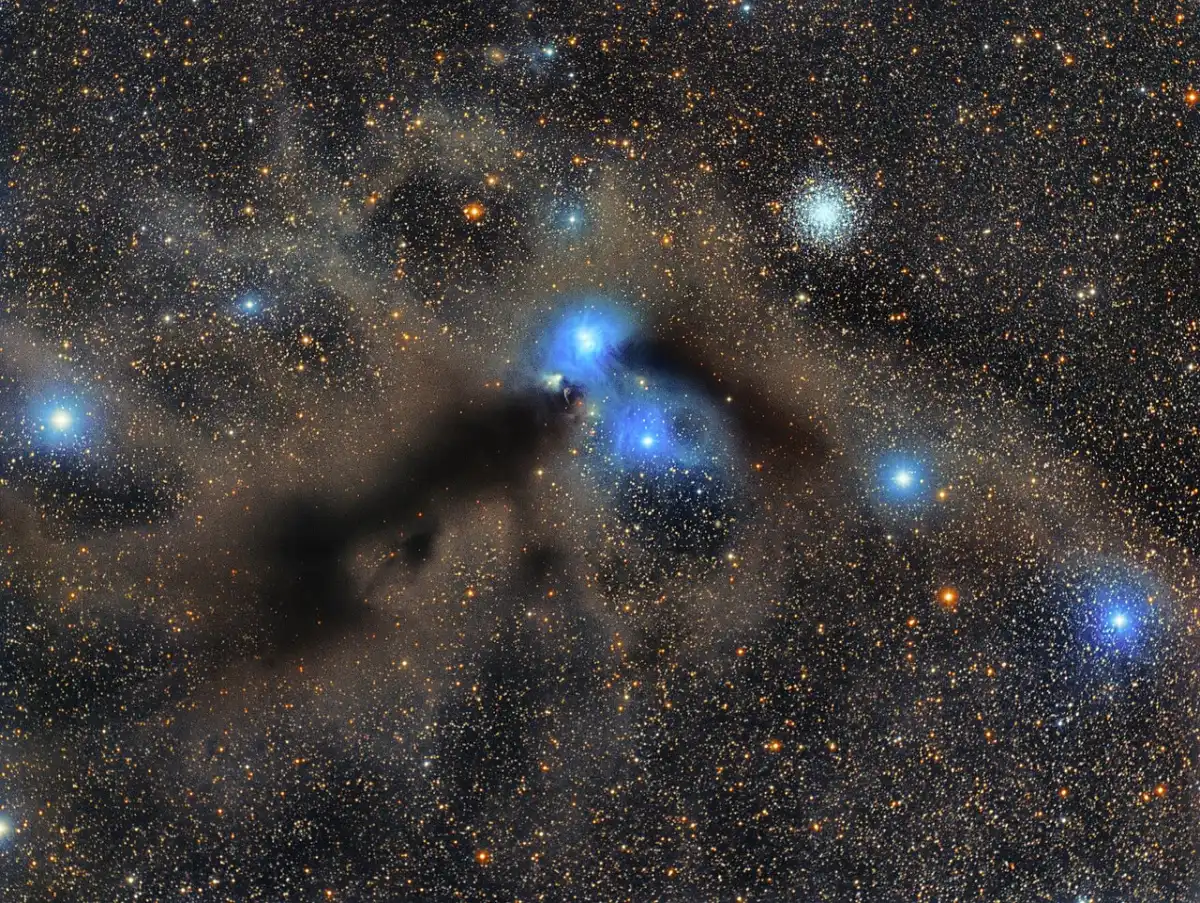
The Corona Australis Molecular Cloud is a dusty nebula and star-forming region with both reflection and absorption components. This image here has a combined exposure of nearly 4 hours of data, shot under very good sky conditions in Mersing, Malaysia. NGC 6723, an ostensibly adjacent globular cluster (but in fact much farther away from Earth than the nebula), is also visible here on the top right of the blue reflection nebula, NGC 6726/67. Image credit: Ivan Bok (CC BY 4.0)
Chandelier Cluster – NGC 6723
| Constellation | Sagittarius |
| Object type | Globular cluster |
| Class | VII |
| Right ascension | 18h 59m 33.15s |
| Declination | –36° 37′ 56.1″ |
| Apparent magnitude | 6.8 |
| Apparent size | 11′ |
| Distance | 28,400 light-years (8,700 parsecs) |
| Mass | 3.57×105 M☉ |
| Age | 13.06 billion years |
| Metallicity [Fe/H] | -0.96 dex |
| Names and designations | Chandelier Cluster, NGC 6723, GCl 106, C 1856-367, CD-36 13199, [KPS2012] MWSC 3033 |